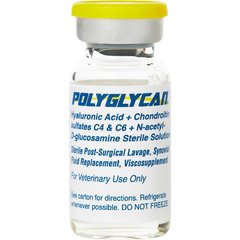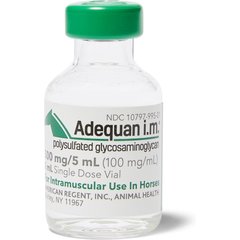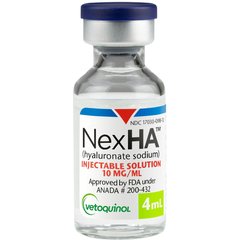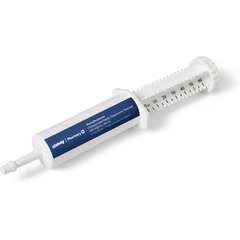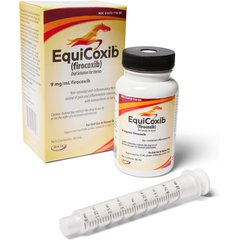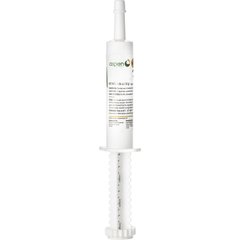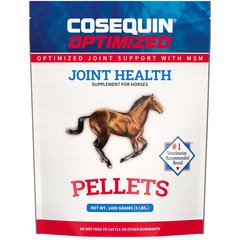Arthritis in Horses: Managing Arthritis in Your Horse

Photo by grandriver/E+
Arthritis, also known as osteoarthritis or degenerative joint disease, causes inflammation and deterioration of joints and cartilage, resulting in pain and lameness. It’s common in horses, especially as they get older, but can occur at any age. Unfortunately, it is chronic and progressive, so you can’t reverse it, but it can be treated and managed.
Osteoarthritis is actually one of several types of arthritis in horses, which also include:
- Traumatic arthritis, caused by an injury
- Septic arthritis, caused by a bacterial infection
- Osteochondrosis, which causes the cartilage to develop abnormally
- Subchondral cysts, which form under cartilage and cause lameness.
We consulted three equine veterinarians to learn about the symptoms, diagnostic methods, and treatments available to help horses with osteoarthritis.
Symptoms of Arthritis in Horses
The symptoms of arthritis might not be obvious at first, but they will become apparent as the condition worsens.
Equine arthritis symptoms include:
- Lameness, limping, abnormal gait
- Painful joints
- Pain, stiffness in the back/spine
- Swollen joints
- Heat surrounding the joints
- Stiffness, especially before warming up for activity
- Cracking or popping sounds with movement
- Reluctance or inability to move, get up, exercise, or work
- Impaired range of motion
- Bumps on the joints
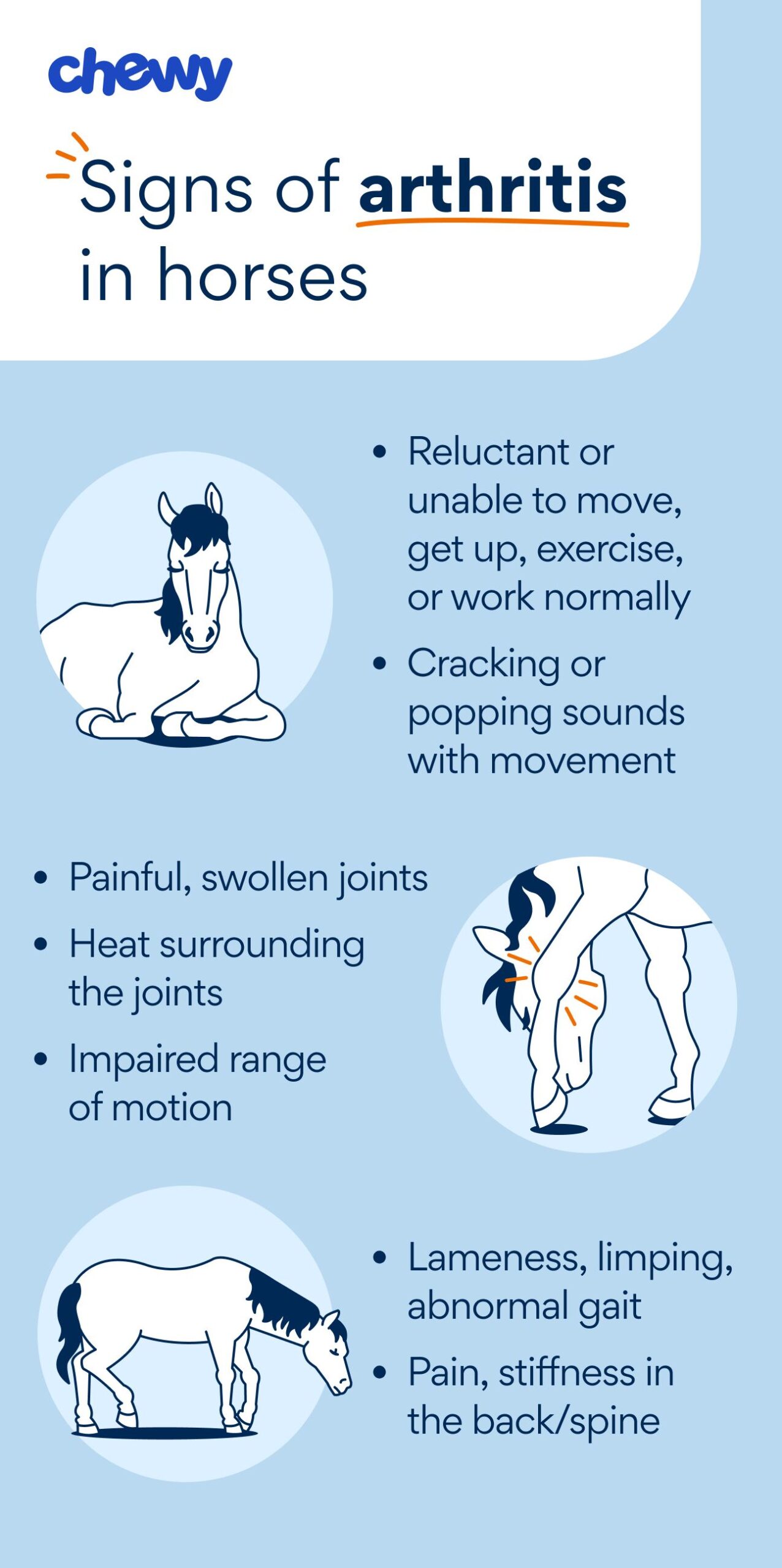
Photo by Chewy
Diagnosing Arthritis in Horses
Because arthritis is progressive, diagnosing it early and providing the proper treatments right away may help improve your horse’s quality of life.
Several methods and tools can be used to diagnose arthritis in a horse:
- A lameness exam will involve watching the horse walk and trot. This can reveal problems before other diagnostic tests are performed.
- A flexion test can determine which joint is causing pain, as it places stress on specific joints to see how the horse reacts and how movement is affected.
- Nerve or joint blocks with local anesthetic can determine the specific joint or part of the leg that is causing lameness. Essentially, an area is numbed to see if the horse moves better afterward. If the horse performs better, it confirms pain in that area.
- X-rays can show changes in a joint that point to arthritis. Those may include osteophytes/bone spurs, loss of joint space, or deformities like fractures.
- CT scans and MRIs can be used to provide more clarity when X-rays aren’t enough to make a diagnosis.
- Ultrasounds can diagnose soft-tissue changes and tendon injuries.
Treatment Options for Arthritis in Horses
Arthritis can’t be cured, but there are treatments that can relieve pain, reduce inflammation, improve mobility, and possibly slow the progression of the disease.
Although there are multiple arthritis remedies for horses, the best ones for your horse will depend on the severity of the arthritis and its location in their body. Your veterinarian can assess your horse’s condition and come up with a treatment plan tailored to their needs.
Steroids and injectable joint supplements
When it comes to arthritis medicine for horses, your veterinarian might recommend injectable treatments, including those that go into the affected joints (known as intra-articular). Examples include:
- Adequan: This is designed to help treat noninfectious degenerative or traumatic joint dysfunction in horses’ carpal and hock joints.
- Hyaluronate sodium (hyaluronic acid): These injectables are designed to help treat joint dysfunction of the carpus (aka forelimb) or fetlock in horses.
- Steroids: These are commonly used to reduce inflammation. They may cause damage to a joint over time if used repeatedly.
Recommended Products
Nonsteroidal medications
Nonsteroidal anti-inflammatory drugs (NSAIDs) can be used to minimize pain and swelling. Examples include:
- Phenylbutazone: This is a pain medication. It can be used in the short term to manage flare-ups of pain, but some veterinarians do not consider it to be a good long-term solution in most cases because of its potential side effects.
- Firocoxib: This is a longer-term pain medication.
- Flunixin meglumine: This medication is designed to help reduce inflammation and pain.
Recommended Products
Modern advancements
New treatment options are available, thanks to advancements in equine care. “The newest therapies reduce inflammation at the cellular level and have various modes of action,” says Bryan M. Waldridge, DVM, MS, DABVP, DACVIM (LA), and associate clinical professor at Mississippi State University.
“Regenerative products, often made from the horse’s own blood, are a great option, as they help to decrease inflammation while not causing damage to the joint like steroids do,” adds Jennifer Schott (Fordham), DVM, associate veterinarian at Lineberger Veterinary Hospital in Gastonia, North Carolina.
Examples of newer therapies include:
- Interleukin-1 Receptor Antagonist Protein (IRAP): This has been shown to help slow the progression of osteoarthritis by preventing interleukin-1, an inflammatory protein, from binding to receptors within joints and causing damage.
- Alpha2EQ: This treatment uses alpha-2-macroglobulin, which is a protein naturally found in the blood of horses. It is anti-inflammatory, and helps reduce the breakdown and loss of cartilage.
Alternative therapies
In addition to conventional treatments, alternative therapies may provide arthritis relief for horses. Examples include:
- Acupuncture
- Chiropractic
- Shockwave therapy
Management of Arthritis
Pain medications, joint injections, and other treatments and therapies are key to tackling the symptoms of arthritis, but you can also manage your horse’s condition to keep them mobile and happy.
Daily Practices for Arthritic Horses
A proper diet with the right supplements can be helpful in maintaining healthy joints. Your vet can provide guidance on which foods to increase and which to avoid.
Supplements that may support joint health include glucosamine, chondroitin, and methylsulfonylmethane (MSM). Cosequin contains all of these. Also, omega-3 fatty acids can help maintain healthy joint function.
Recommended Products
Keeping your horse at a healthy weight can help prevent straining the joints further. If necessary, work with your vet to help your horse lose weight safely.
You can also work with a farrier to see if shoes or boots would benefit your horse.
Exercise Routines for Horses With Arthritis
Rest is important for recovery, and Dr. Waldridge advises allowing your horse to rest when it’s needed. However, too much inactivity can promote stiffness.
Gentle daily activity, turnout, and exercise are important, especially once your horse is given treatments that reduce pain and make it possible for them to be active.
Talk to your veterinarian about the exercise routine that’s suitable for your individual horse. Before activity, allow them to gently warm up, especially if their joints and muscles are stiff.
Knowing When To Consider Humane Euthanasia
Horses can live for years with arthritis that’s properly managed. But if it becomes so severe that it prevents them from living a comfortable and happy life, humane euthanasia may need to be considered.
“At some point, the horse may become uncomfortable and suffer constantly. They may get down and have trouble or be unable to rise. Those are signals,” says Kenneth E. Sullins, DVM, MS, DACVS, professor of equine surgery and chair of the Department of Equine Medicine and Surgery at Midwestern University.
FAQs About Arthritis in Horses
Can you ride a horse that has arthritis?
Whether a horse should be ridden depends on the affected joint and the severity of their condition. “Arthritis in the knee joint or fetlock can cause much more pain due to increased movement in these joints, and more pain when the horse is being ridden,” says Dr. Schott. Consult your veterinarian about whether they recommend you ride your horse.
How long can a horse live with arthritis?
Though horses with arthritis might need lifelong treatment for their comfort, they may live a long life despite this condition.
Attributions
This content was medically reviewed by Teresa Manucy, DVM, Chewy veterinarian.
